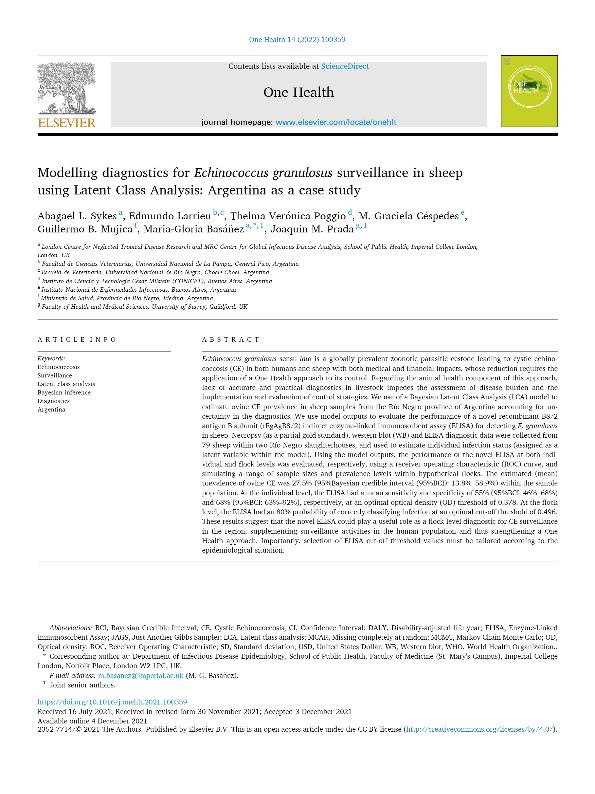Artículo
Modelling diagnostics for Echinococcus granulosus surveillance in sheep using Latent Class Analysis: Argentina as a case study
Abagael L. Sykes; Larrieu, Edmundo Juan; Poggio, Thelma Veronica ; Céspedes, M. Graciela; Mujica, Guillermo Bernardo; Basáñez, Maria Gloria; Prada, Joaquin M.
; Céspedes, M. Graciela; Mujica, Guillermo Bernardo; Basáñez, Maria Gloria; Prada, Joaquin M.
 ; Céspedes, M. Graciela; Mujica, Guillermo Bernardo; Basáñez, Maria Gloria; Prada, Joaquin M.
; Céspedes, M. Graciela; Mujica, Guillermo Bernardo; Basáñez, Maria Gloria; Prada, Joaquin M.
Fecha de publicación:
03/2022
Editorial:
Elsevier
Revista:
One Health
ISSN:
2352-7714
Idioma:
Inglés
Tipo de recurso:
Artículo publicado
Clasificación temática:
Resumen
Echinococcus granulosus sensu lato is a globally prevalent zoonotic parasitic cestode leading to cystic echinococcosis (CE) in both humans and sheep with both medical and financial impacts, whose reduction requires the application of a One Health approach to its control. Regarding the animal health component of this approach, lack of accurate and practical diagnostics in livestock impedes the assessment of disease burden and the implementation and evaluation of control strategies. We use of a Bayesian Latent Class Analysis (LCA) model to estimate ovine CE prevalence in sheep samples from the Río Negro province of Argentina accounting for uncertainty in the diagnostics. We use model outputs to evaluate the performance of a novel recombinant B8/2 antigen B subunit (rEgAgB8/2) indirect enzyme-linked immunosorbent assay (ELISA) for detecting E. granulosus in sheep. Necropsy (as a partial gold standard), western blot (WB) and ELISA diagnostic data were collected from 79 sheep within two Río Negro slaughterhouses, and used to estimate individual infection status (assigned as a latent variable within the model). Using the model outputs, the performance of the novel ELISA at both individual and flock levels was evaluated, respectively, using a receiver operating characteristic (ROC) curve, and simulating a range of sample sizes and prevalence levels within hypothetical flocks. The estimated (mean) prevalence of ovine CE was 27.5% (95%Bayesian credible interval (95%BCI): 13.8%–58.9%) within the sample population. At the individual level, the ELISA had a mean sensitivity and specificity of 55% (95%BCI: 46%–68%) and 68% (95%BCI: 63%–92%), respectively, at an optimal optical density (OD) threshold of 0.378. At the flock level, the ELISA had an 80% probability of correctly classifying infection at an optimal cut-off threshold of 0.496. These results suggest that the novel ELISA could play a useful role as a flock-level diagnostic for CE surveillance in the region, supplementing surveillance activities in the human population and thus strengthening a One Health approach. Importantly, selection of ELISA cut-off threshold values must be tailored according to the epidemiological situation.
Archivos asociados
Licencia
Identificadores
Colecciones
Articulos(ICT - MILSTEIN)
Articulos de INST.DE CS. Y TECNOLOGIA "DR. CESAR MILSTEIN"
Articulos de INST.DE CS. Y TECNOLOGIA "DR. CESAR MILSTEIN"
Citación
Abagael L. Sykes; Larrieu, Edmundo Juan; Poggio, Thelma Veronica; Céspedes, M. Graciela; Mujica, Guillermo Bernardo; et al.; Modelling diagnostics for Echinococcus granulosus surveillance in sheep using Latent Class Analysis: Argentina as a case study; Elsevier; One Health; 14; 3-2022; 1-7
Compartir
Altmétricas



